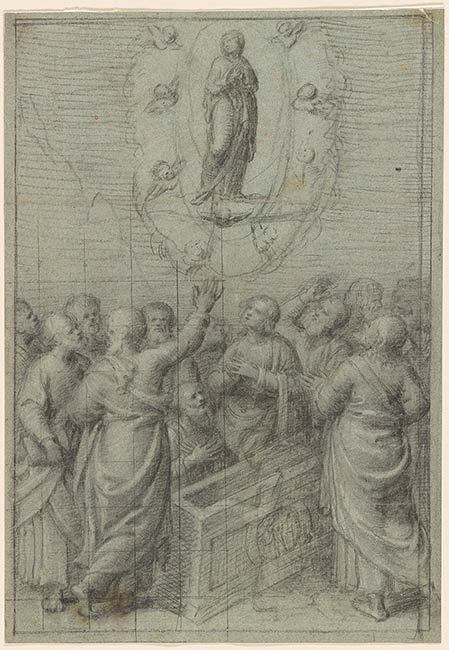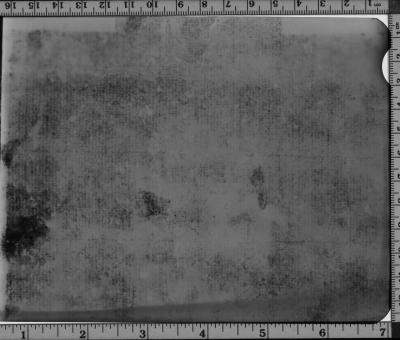
After a brief apprenticeship with his father, who was a goldsmith, Bernardino Campi entered the workshop of Giulio Campi in Cremona, who appears not to have been a blood relation. Bernardino then briefly worked in Mantua under the Giulio Romano follower Ippolito Costa, but by 1541 he had returned to Cremona, where most of his surviving work is found. He often drew in black chalk on colored paper, lightly smudging the chalk to achieve subtle tonalities or applying it with a sharpened tip for deeper shadows. The rich modulation through the use of white chalk reveals the dominant influence of Camillo Boccaccino and Giulio Campi on his style.
Few finished compositional studies by Bernardino are known, and only a couple of these are as impressive as the present drawing. It is a finished preparatory study for Bernardino’s signed painting of the Assumption of the Virgin with Canon Facio Trezzi in the church of Sant’Agata, and thus the earliest known drawing by the artist. Old photographs of the painting reveal a date usually interpreted as 1542.1 A slightly later date of 1544–45 was once assumed because of archival documents, but these were discovered to relate to the frame rather than to the panel itself.2 Catalogued in 1912 as school of Cremona by Charles Fairfax Murray, the drawing was first attributed to Bernardino Campi by Philip Pouncey.3
The painting was commissioned by Facio Trezzi or Trecchi, a priest with a distinguished surname who, however, was likely not related to the illustrious Trecchi family of Cremona, or, if so, only very distantly. He commissioned the work in connection with his first and possibly most profitable benefice, that of the perpetual chaplaincy of the altar of the Assumption of the Virgin in the parish church of Santa Margherita in Cremona, which he received in 1531. When Trezzi renounced this benefice, the painting was transferred from Santa Margherita to his home, and, after his death on 8 September 1570, was bequeathed to the church of Sant’Agata, where it was set up early in 1571.4 It now hangs in the chapel adjacent to the choir, off the left transept.
The design seems to have been conceived initially without the figure of the donor, who is only faintly outlined, kneeling in front of the sarcophagus and peering into it with head bent. In the painting, he gazes toward the heavens and almost completely obscures the sarcophagus. His large figure, dressed in white, provides a prominent counterweight to the luminous vision of the Virgin above. The standing figure of the Virgin in the design may have seemed too slight and inconsequential in comparison to the gathering below. For the final version her proportions were enlarged and her draperies extended, but, because she is shown kneeling, she occupies only the same compositional height as before.
—REP
Footnotes:
- Cremona 1985, no. 1.15.1; Voltini 1998, 53.
- Robert Miller in Cremona 1997–98, 46n42.
- As noted in Stampfle 1975, 246.
- Giorgio Politi in Cremona 1985, 33–39.
Formerly attributed to Anonymous Italian School, 16th century.
Inscribed on verso of lining, at lower center, in graphite, "26".
Watermark: Indecipherable image in circle, lined.
Anonymous, Italian School, 16th cent., Formerly attributed to.
Murray, Charles Fairfax, 1849-1919, former owner.
Morgan, J. Pierpont (John Pierpont), 1837-1913, former owner.
Collection J. Pierpont Morgan : Drawings by the Old Masters Formed by C. Fairfax Murray. London : Privately printed, 1905-1912, IV, 156, repr.
Felice, Stampfle, "A Campi Drawing in the Morgan Library," Burlington, 117, April 1975, pp. 245-46, fig. 77.
Rhoda Eitel-Porter and and John Marciari, Italian Renaissance Drawings at the Morgan Library & Museum, New York, 2019, no. 84.
Selected references: Fairfax Murray 1905-12, 4: no. 156 (as Cremona school); Stampfle 1975, 245-46; Cremona 1985, under no. 1.15.1 and under no. 2.10.1; New York and Chicago 1994, no. 50.

